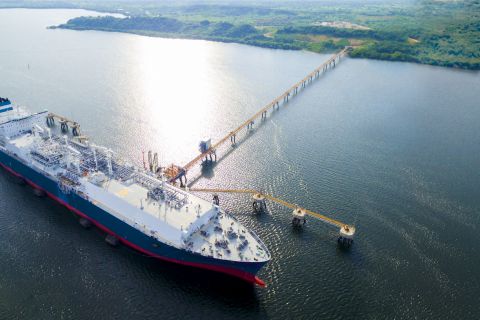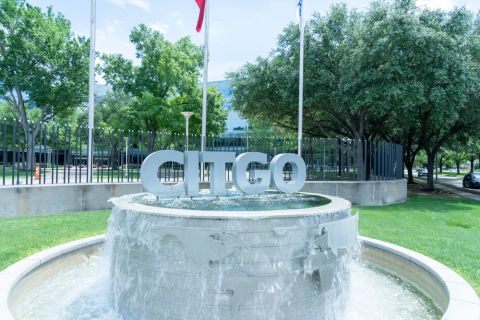
About 20 years ago BP made a breakthrough discovery with its partners at the University of Wyoming. Everything reservoir engineers had been taught about the types of water to use in sandstone waterfloods was about to change.
It would take another decade of research to get an opportunity to put what they’d learned in the labs to the test in a real environment—Alaska’s Endicott Field. The result of that multimillion-dollar trial became what BP calls “the single biggest step-change since waterflooding began,” also known as its “LoSal EOR” process.
Industry convention cautioned against injecting freshwater in a reservoir for fear that it would cause the clay to expand and swell, destroying the reservoir’s permeability. But the truth, as the team at BP soon discovered, was the opposite. They found they could produce significantly more oil from the mature reservoir by using the patented LoSal EOR process than they could by using seawater.
Those results won the British oil giant the world’s first sanctioned offshore low-salinity project at Clair Ridge in the U.K.
Clair Ridge
Clair Field is located 75 km (46 miles) west of Shetland in water approximately 140 m (459 ft) deep. Authorized to begin building the first fixed platform in 2001, the Clair co-venturers began production in February 2005 at Clair and had reached around 90 MMbbl midway through 2013.
Phase 2 of the project, known as Clair Ridge, will include two new bridge-linked platforms and pipeline infrastructure that will connect to processing facilities on Shetland. According to an August 2013 BP press release, the platform jackets—named Odin and Frigg—have already been successfully installed at Clair Ridge.
Installation of the platforms’ topsides is expected to be complete by 2015, with production coming online by late 2016. When it’s complete, the Clair Ridge development will be capable of producing an estimated 640 MMbbl over a 40-year period, with peak production expected to be 120,000 bbl/d, according to the BP press release.
Unlocking a reservoir’s potential
The BP Pushing Reservoir Limits (PRL) team comprises experts in EOR who are tasked with finding new ways to innovate by questioning conventional wisdom on the matter. Once the question was asked—Can using fresher water in an EOR flood help improve oil recovery in a mature offshore well?—the experiments began.
The team collected sandstone samples from around the world, wherever BP worked. It then flooded the samples with water containing varying amounts of salt to test its theories and determine what chemistry released the most oil. Next, it conducted several near-wellbore and single-well tests in various oil fields to prove the technology would work in the field. The team at BP discovered that below a threshold of salinity, more oil was produced.
“In the pore space (of the clay) there are divalent ions that are attached to the clay,” Andrew Cockin, PRL technology innovation leader, explained in a company video. “Divalent ions have two arms—one arm can be attached to the clay particle, and the other arm can be attached to the oil molecule. The trick is to be able to get in there and change out these divalent ions with the two arms and put a monovalent ion in there. It’s only got one arm, so it can hold onto the clay or it can hold onto the oil, but it can’t hold onto both.”
The answer, the team discovered, would be to flood the well with water containing lots of monovalent ions. But it wasn’t that simple. Cockin went on to explain in the video that in a high-salinity environment the oil molecules are compressed and latch tightly onto the clay. This serves as a barrier of sorts that prevents the monovalent ions from being able to replace the divalent ions. However, he said that in a low-salinity environment things are more “relaxed” and decompressed, allowing the monovalent ions to trade places with many of the divalent ions, thereby loosening more of the oil from the clay.
After this phenomenon was observed, the PRL team ensured the test water was low in salinity and, importantly, had few if any divalent ions while ripe with monovalent ions.
Endicott testing proves lab results
Once this winning LoSal cocktail was supplying the team with consistent results in the lab, the company was ready to put the new technology to the test in the mature Endicott Field located on Alaska’s North Slope. It provided the PRL team with an ideal testing ground because it had already been flooded with seawater, and those results were well-documented, Cockin told E&P. Doing anything new to the field was going to provide instant results for comparison.
“Because the Endicott Field had already undergone a high-salinity waterflood, it provided a baseline against which improvements could be evaluated,” he said. “The trial involved injecting low-salinity water into a well, which generated a bank of incremental oil, which then appeared at the production well at the same time as the water being produced there changed from high salinity to low salinity.”
As Cockin explained in the project video, the primary objective from the start of the trial was to ensure an unambiguous response. The PRL team chose an isolated corner of Endicott Field that wouldn’t be impacted by the regular field operations, and once it had the test wells set up, it ensured it had multiple layers of surveillance in place to record the results. What it discovered was that the results produced in the field matched those it had recorded in the lab. LoSal EOR was ready for market.
The future of waterflooding
In 2009 BP decided it would make LoSal EOR the default approach for all future sandstone waterfloods. Cockin told E&P that the LoSal EOR operation at Clair Ridge will help make “the second and subsequent deployments more routine” for the operator.
“Many EOR methods are complex and involve high-cost chemicals or thermal energy; these can prove uneconomic, even at today’s relatively high oil prices,” he said. “LoSal EOR technology does not involve expensive chemicals, and its only incremental cost above conventional sea waterflooding is the desalination module. This makes LoSal EOR low-cost and low-risk—a breakthrough for waterflooding.”
Cockin said the desalination module is “a specially designed reverse-osmosis module built to desalinate seawater to the optimum salinity” for injection. It takes only minutes to render the seawater usable for EOR, he said. He added that ultimately it is BP’s goal to recover 42 million incremental barrels of oil from its Clair Ridge project.
Contact the author, Amy Logan, at alogan@hartenergy.com. Image is courtesy of BP.
Recommended Reading
Glenfarne: Latest Customer Means Texas LNG is Ready for FID
2024-09-12 - Construction on Glenfarne’s Texas LNG is scheduled to begin this year, though the project is one of two LNG sites that had permits pulled after a court ruling in August.
FTC Oks Chevron-Hess Deal, Bans John Hess from Board
2024-09-30 - Federal regulators signed off on a blockbuster tie-up between Chevron and Hess Corp. but banned CEO John Hess from sitting on the Chevron board.
Venezuela Lost Citgo, But the Battle’s Not Over Yet
2024-10-04 - Amber Energy’s $7.3 billion purchase of Citgo fell well short of analyst’s valuations. PDVSA Ad Hoc expects to appeal the decision soon in its battle to protect its claim on Citgo.
Quantum Teams Looking for Acquisitions ‘Off the Beaten Path’
2024-10-14 - Blake Webster, partner at Quantum Capital Group, said the private-equity firm’s portfolio teams are looking to buy from sellers looking for cash buyouts, though not necessarily in the usual places.
Diamondback Subsidiary Viper Closes $900MM Midland Royalty Deal
2024-10-02 - Diamondback Energy’s Viper Energy closed the last of three acquisitions from Tumbleweed Royalty, owned by Double Eagle Energy’s founders, that together totaled about $1.1 billion.
Comments
Add new comment
This conversation is moderated according to Hart Energy community rules. Please read the rules before joining the discussion. If you’re experiencing any technical problems, please contact our customer care team.





